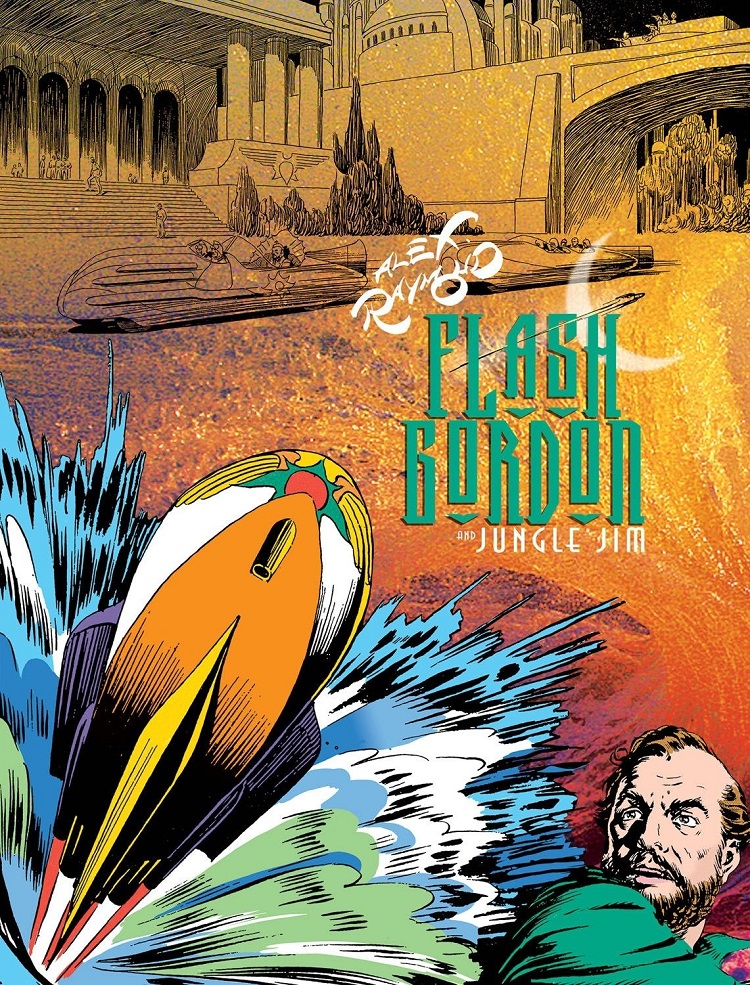
This fourth and final volume of The Library of American Comics’ series reprinting Alex Raymond’s Sunday strips of Flash Gordon and its topper Jungle Jim begins on January 4, 1942, less than a month after the bombing of Pearl Harbor and the U.S. joining the Allied Forces.
World War II had a great impact on the strip. Jim Bradley’s adventures found the character traveling the globe to foil plots by the Japanese and the Germans. Flash Gordon did his part for the war effort as well, but his mission required a return to the planet Mongo to retrieve radium. Once there, he was distracted from his goal and the stories became metaphoric as he led an underground against a tyrant who seized power. The most notable impact the war had was on Raymond himself, who was compelled by his sense of duty and patriotism to join the U.S. Marine Corps in February 1944. Although the last strips in the book were published on August 13, 1944, Raymond’s final strips were April 30 (Flash Gordon was taken over by Austin Briggs, who created the daily Flash strips from 1940-1944) and May 21 (Jungle Jim was taken over by John Mayo).
This final volume was my first introduction to Raymond’s work and Jungle Jim. I knew of Flash Gordon from the films starring Buster Crabbe and the one from 1980 produced by Dino De Laurentiis. Though fighting on different worlds, the main characters have similar traits. They are smart, tough, righteous men who may suffer minor defeat at the hands of the villains, but they eventually triumph in the long run.
They also make many women swoon, which comes across a bit ridiculous when reading the strips over 70 years past their publication. Flash’s gal Dale can be a bit of a frail flower and jealous of any woman who seems captivated by Flash, but Raymond also allows her moments of strength, as she frequently rescues Flash when he gets in over his head.
The stories, which were co-written by Don Moore, deliver good plot twists, even if the eventual results aren’t surprising and some of the characters are under developed and even forgotten, like Dr. Zarkov, who is last seen during the takeover of the town Placida on July 25, 1943. Although the Japanese are understandably not depicted well in Jungle Jim, it was good to see Raymond create other heroic Asian characters like Jim’s Malaysian sidekick Kolu, who lightly treads the border of being an uncomfortable stereotype, and the Chinese soldiers who fought beside Jim.
Where the book and Raymond really shine is the artwork, and the oversized 12″ x 16″ champagne edition format is a great way to present it (except for those who like to read in bed). Although one strip is set in the real world and the other on a fictional planet, Raymond’s panels show great skill regardless of the setting. Through his line work and use of color, he creates believable backgrounds, and in Flash Gordon, he also exhibits great imagination in the creation of the continent Tropica’s flora and fauna. Raymond also reveals a playfulness. During a four-week period, Flash and others have to walk on the ceiling as they travel through a tunnel where gravity is reversed. They are drawn upside down while the text is right side up. Some of the strips show very fine lines and bright colors while others don’t appear reproduced with the same level of clarity.
While the characters continued under different creators and in different formats, Flash Gordon and Jungle Jim, Vol. 4: 1942-1944 is the last time to see them in the hands of their originator, Alex Raymond. These strips serve as a good source of entertainment to readers and a great source of inspiration to artists.